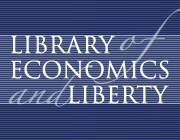
Milton Friedman |

Friedman established himself in 1945 with Income from Independent Professional Practice, coauthored with Simon Kuznets. In it he argued that state licensing procedures limited entry into the medical profession, thereby allowing doctors to charge higher fees than if competition were more open.
His landmark work of 1957, A Theory of the Consumption Function, took on the Keynesian view that individuals and households adjust their expenditures on consumption to reflect their current income. Friedman showed that, instead, people's annual consumption is a function of their expected lifetime earnings.
In Capitalism and Freedom, Friedman liberated the study of market economics from its ivory tower and brought it down to earth. He argued for, among other things, a volunteer army, freely floating exchange rates, abolition of licensing of doctors, a negative income tax, and education vouchers. (Friedman is a passionate foe of the military draft: he once stated that the abolition of the draft was the only issue on which he had personally lobbied Congress.) Although his book did not sell well, many of the young people who did read it were encouraged by it to study economics themselves. His ideas spread worldwide with Free to Choose (coauthored with his wife, Rose Friedman), the best-selling nonfiction book of 1980, written to accompany a TV series on the Public Broadcasting System. This book made Milton Friedman a household name.
Although much of his trail-blazing work was done on price theory—the theory that explains how prices are determined in individual markets—Friedman is popularly recognized for monetarism. Defying Keynes and most of the academic establishment of the time, Friedman presented evidence to resurrect the quantity theory of money—the idea that the price level is dependent upon the money supply. In Studies in the Quantity Theory of Money, published in 1956, Friedman stated that in the long run, increased monetary growth increases prices but has little or no effect on output. In the short run, he argued, increases in the money supply cause employment and output to increase, and decreases in the money supply have the opposite effect.
Friedman's solution to the problems of inflation and short-run fluctuations in employment and real GNP was a so-called money supply rule. If the Federal Reserve board were required to increase the money supply at the same rate as real GNP increased, he argued, inflation would disappear. Friedman's monetarism came to the forefront when, in 1963, he and Anna Schwartz coauthored Monetary History of the United States, 1867-1960. In it they contend that the Great Depression was the result of ill-conceived monetary policies by the Federal Reserve. Upon receipt of the unpublished manuscript submitted by the authors, the Federal Reserve board responded internally with a lengthy critical review. Such was their agitation that the Fed governors discontinued their policy of releasing minutes from the board's meetings to the public. Additionally, they commissioned a counterhistory to be written (by Elmus R. Wicker) in the hope of detracting from Monetary History.
Although many economists disagree with Friedman's monetarist ideas, he has substantial influence on the profession. One measure of that influence is the change in the treatment of monetary policy given by MIT Keynesian Paul Samuelson in his best-selling textbook, Economics. In the 1948 edition Samuelson wrote dismissively that "few economists regard Federal Reserve monetary policy as a panacea for controlling the business cycle." But in 1967 Samuelson said that monetary policy had "an important influence" on total spending. The 1985 edition, coauthored with Yale's William Nordhaus, states, "Money is the most powerful and useful tool that macroeconomic policymakers have," adding that the Fed "is the most important factor" in making policy.
Throughout the sixties Keynesians—and mainstream economists generally—had believed that the government faced a stable long-run trade-off between unemployment and inflation—the so-called Phillips Curve. In this view the government could, by increasing the demand for goods and services, permanently reduce unemployment by accepting a higher inflation rate. But in the late sixties Friedman (and Columbia University's Edmund Phelps) challenged this view. Friedman argued that once people adjusted to the higher inflation rate, unemployment would creep back up. To keep unemployment permanently lower, he said, would require not just a higher, but a permanently accelerating inflation rate. (See Phillips Curve.)
The stagflation of the seventies—rising inflation combined with rising unemployment—gave strong evidence for the Friedman-Phelps view and swayed most economists, including many Keynesians. Again, Samuelson's text is a barometer of the change in economists' thinking. The 1967 edition indicated that policymakers faced a trade-off between inflation and unemployment. The 1980 edition said there was less of a trade-off in the long run than in the short run. The 1985 edition says there is no long-run trade-off.
No other economist since Keynes has reshaped the way we think about and use economics as much as Milton Friedman. By his scope of topics and magnitude of ideas, Friedman has not only laid a cornerstone of contemporary economic thought but has also built an entire construction.
Capitalism and Freedom. 1962.
An Economist's Protest: Columns on Political Economy. 1972.
Essays in Positive Economics. 1953.
(With Rose Friedman.) Free to Choose. 1980.
(With Simon Kuznets.) Income from Independent Professional Practice. 1945.
(With Anna J. Schwartz.) A Monetary History of the United States, 1867-1960. 1963.
Price Theory: A Provisional Text. 1962.
(Ed.) Studies in the Quantity Theory of Money. 1956.
A Theory of the Consumption Function. 1957.
Podcasts: Milton Friedman and Russ Roberts converse at the Hoover Institute in 2006:
Milton Friedman and Money.
Friedman and Capitalism and Freedom.
Transcript of both podcasts.
